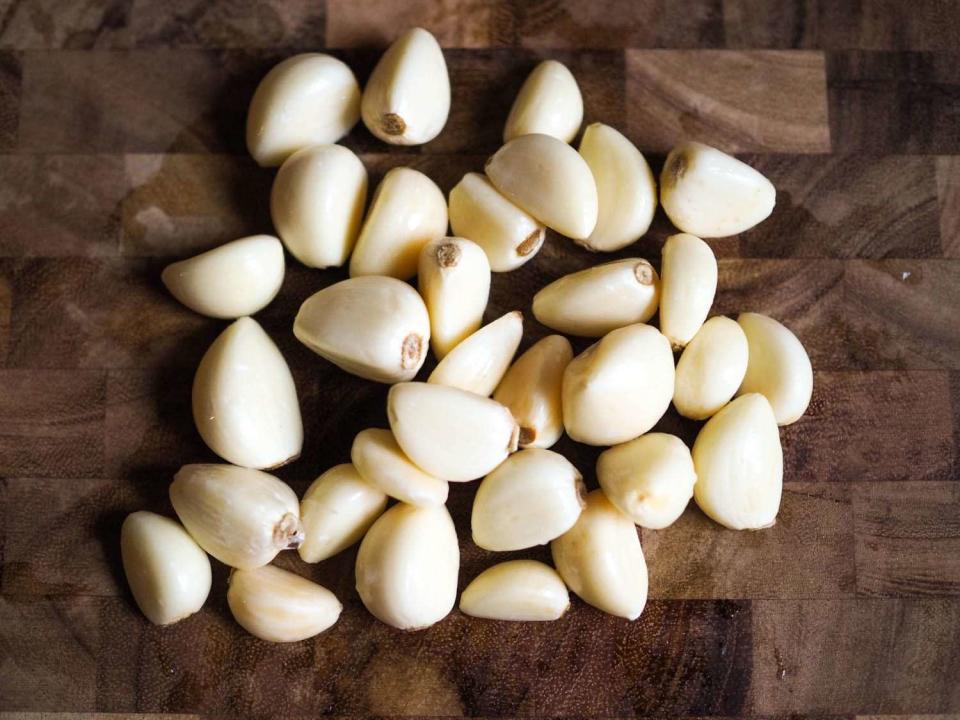Why Does My Garlic Turn Green? | Ask The Food Lab
What it means when garlic changes color, and how it impacts flavor.

“Why Does Garlic Turn Green, and How Does It Affect Flavor?”
Recently, I have had problems with garlic in my dishes turning blue-green. I feel like when this happens the garlic flavor is stronger, and my boyfriend finds it to have an off-putting taste. What's going on here, and does it make sense that it would change the flavor?
—Sent by Lauren D
Like you, I didn't notice this phenomenon—cut garlic turning green as it sits in the air or as I cook it—until after I moved to a new city, in my case to Boston from New York. What gives?
Turns out that the reactions that create this blue pigment are related to the reactions that create the familiar pungent aroma of garlic and onions. The chemical precursors of these compounds start out safely locked away within individual cells in the plant, but as you cut or grate them, they get exposed to each other, where they end up reacting, with the aid of enzymes.
According to a 2006 New York Times article from Harold McGee, under certain conditions, the chemical precursors will "react with each other and with common amino acids to make pyrroeles, clusters of carbon-nitrogen rings." When these rings then link together in a specific way, they form green compounds that are similar in structure to green chlorophyll. The molecules are perfectly safe to eat.
Why Does Some (but Not All) Garlic Turn Green?
So why does some garlic turn green and others not? It has to do with the garlic's age. Older garlic will build up larger quantities of chemical precursors than fresher garlic, thus both the region in which you buy your garlic and the specific markets in which you are purchasing it can affect how likely it is to form these blue-green compounds.
Since the colored compounds are created from the same chemical precursors as aromatic compounds, your perception that garlic that turns green has a stronger flavor than garlic that stays white is spot on. Indeed, level of greenness is almost a direct litmus test for how strong your garlic will taste.

McGee notes that in some parts of the world, the color is specifically accentuated by cooking the garlic in acid (low pH environments are more conducive to the reaction occurring).
The northern Chinese think of them as attractive and auspicious. They make an intentionally intensely green pickle by aging fresh garlic heads for several months, then peeling the cloves and immersing them in vinegar for a week. The resulting Laba garlic pickle is served with dumplings to celebrate the New Year.
How to Prevent Garlic from Turning Green
So how can you prevent the greenness (and resulting strong flavor) from occurring if you prefer your garlic milder?
A number of ways.
Work quickly, keep your garlic cold, and cook hot. As soon as you start cutting or grating garlic, chemical reactions begin occurring. These reactions are sped up with higher temperatures, so it's a good idea to keep your garlic in the fridge to minimize them. Similarly, sweating garlic or simmering it at relatively low temperatures can cause it to rapidly turn green. If you have garlic prone to greenness, cook it at a higher temperature in order to deactivate the enzymes.
Cook your garlic and onions separately. Raw onions contain many of the same precursors that garlic do, so when you grate or chop them together, you are essentially providing the garlic with extra building blocks with which to created green pigments. When sautéeing or sweating onions and garlic it's a good idea to cook the onion first to bind or denature its precursors before adding your garlic to the pot.
Don't add acid at the beginning. Acid can increase the rate of pigment production. If you are working on a recipe that includes both acid and garlic, give the garlic a chance to cook down a bit before adding the acid in order to deactivate its enzymes.

